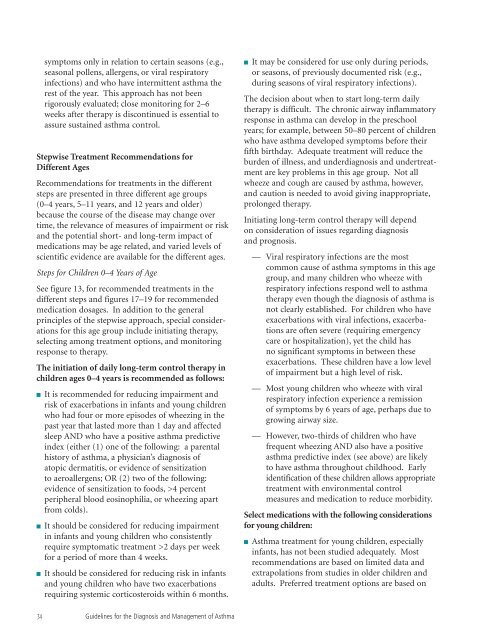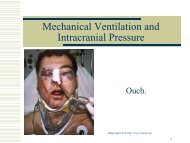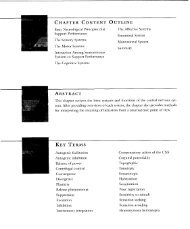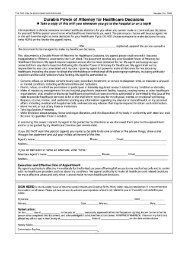Guidelines for the Diagnosis and Management of Asthma
Guidelines for the Diagnosis and Management of Asthma
Guidelines for the Diagnosis and Management of Asthma
Create successful ePaper yourself
Turn your PDF publications into a flip-book with our unique Google optimized e-Paper software.
symptoms only in relation to certain seasons (e.g.,<br />
seasonal pollens, allergens, or viral respiratory<br />
infections) <strong>and</strong> who have intermittent asthma <strong>the</strong><br />
rest <strong>of</strong> <strong>the</strong> year. This approach has not been<br />
rigorously evaluated; close monitoring <strong>for</strong> 2–6<br />
weeks after <strong>the</strong>rapy is discontinued is essential to<br />
assure sustained asthma control.<br />
Stepwise Treatment Recommendations <strong>for</strong><br />
Different Ages<br />
Recommendations <strong>for</strong> treatments in <strong>the</strong> different<br />
steps are presented in three different age groups<br />
(0–4 years, 5–11 years, <strong>and</strong> 12 years <strong>and</strong> older)<br />
because <strong>the</strong> course <strong>of</strong> <strong>the</strong> disease may change over<br />
time, <strong>the</strong> relevance <strong>of</strong> measures <strong>of</strong> impairment or risk<br />
<strong>and</strong> <strong>the</strong> potential short- <strong>and</strong> long-term impact <strong>of</strong><br />
medications may be age related, <strong>and</strong> varied levels <strong>of</strong><br />
scientific evidence are available <strong>for</strong> <strong>the</strong> different ages.<br />
Steps <strong>for</strong> Children 0–4 Years <strong>of</strong> Age<br />
See figure 13, <strong>for</strong> recommended treatments in <strong>the</strong><br />
different steps <strong>and</strong> figures 17–19 <strong>for</strong> recommended<br />
medication dosages. In addition to <strong>the</strong> general<br />
principles <strong>of</strong> <strong>the</strong> stepwise approach, special considerations<br />
<strong>for</strong> this age group include initiating <strong>the</strong>rapy,<br />
selecting among treatment options, <strong>and</strong> monitoring<br />
response to <strong>the</strong>rapy.<br />
The initiation <strong>of</strong> daily long-term control <strong>the</strong>rapy in<br />
children ages 0–4 years is recommended as follows:<br />
■ It is recommended <strong>for</strong> reducing impairment <strong>and</strong><br />
risk <strong>of</strong> exacerbations in infants <strong>and</strong> young children<br />
who had four or more episodes <strong>of</strong> wheezing in <strong>the</strong><br />
past year that lasted more than 1 day <strong>and</strong> affected<br />
sleep AND who have a positive asthma predictive<br />
index (ei<strong>the</strong>r (1) one <strong>of</strong> <strong>the</strong> following: a parental<br />
history <strong>of</strong> asthma, a physician’s diagnosis <strong>of</strong><br />
atopic dermatitis, or evidence <strong>of</strong> sensitization<br />
to aeroallergens; OR (2) two <strong>of</strong> <strong>the</strong> following:<br />
evidence <strong>of</strong> sensitization to foods, >4 percent<br />
peripheral blood eosinophilia, or wheezing apart<br />
from colds).<br />
■ It should be considered <strong>for</strong> reducing impairment<br />
in infants <strong>and</strong> young children who consistently<br />
require symptomatic treatment >2 days per week<br />
<strong>for</strong> a period <strong>of</strong> more than 4 weeks.<br />
■ It should be considered <strong>for</strong> reducing risk in infants<br />
<strong>and</strong> young children who have two exacerbations<br />
requiring systemic corticosteroids within 6 months.<br />
■ It may be considered <strong>for</strong> use only during periods,<br />
or seasons, <strong>of</strong> previously documented risk (e.g.,<br />
during seasons <strong>of</strong> viral respiratory infections).<br />
The decision about when to start long-term daily<br />
<strong>the</strong>rapy is difficult. The chronic airway inflammatory<br />
response in asthma can develop in <strong>the</strong> preschool<br />
years; <strong>for</strong> example, between 50–80 percent <strong>of</strong> children<br />
who have asthma developed symptoms be<strong>for</strong>e <strong>the</strong>ir<br />
fifth birthday. Adequate treatment will reduce <strong>the</strong><br />
burden <strong>of</strong> illness, <strong>and</strong> underdiagnosis <strong>and</strong> undertreatment<br />
are key problems in this age group. Not all<br />
wheeze <strong>and</strong> cough are caused by asthma, however,<br />
<strong>and</strong> caution is needed to avoid giving inappropriate,<br />
prolonged <strong>the</strong>rapy.<br />
Initiating long-term control <strong>the</strong>rapy will depend<br />
on consideration <strong>of</strong> issues regarding diagnosis<br />
<strong>and</strong> prognosis.<br />
— Viral respiratory infections are <strong>the</strong> most<br />
common cause <strong>of</strong> asthma symptoms in this age<br />
group, <strong>and</strong> many children who wheeze with<br />
respiratory infections respond well to asthma<br />
<strong>the</strong>rapy even though <strong>the</strong> diagnosis <strong>of</strong> asthma is<br />
not clearly established. For children who have<br />
exacerbations with viral infections, exacerbations<br />
are <strong>of</strong>ten severe (requiring emergency<br />
care or hospitalization), yet <strong>the</strong> child has<br />
no significant symptoms in between <strong>the</strong>se<br />
exacerbations. These children have a low level<br />
<strong>of</strong> impairment but a high level <strong>of</strong> risk.<br />
— Most young children who wheeze with viral<br />
respiratory infection experience a remission<br />
<strong>of</strong> symptoms by 6 years <strong>of</strong> age, perhaps due to<br />
growing airway size.<br />
— However, two-thirds <strong>of</strong> children who have<br />
frequent wheezing AND also have a positive<br />
asthma predictive index (see above) are likely<br />
to have asthma throughout childhood. Early<br />
identification <strong>of</strong> <strong>the</strong>se children allows appropriate<br />
treatment with environmental control<br />
measures <strong>and</strong> medication to reduce morbidity.<br />
Select medications with <strong>the</strong> following considerations<br />
<strong>for</strong> young children:<br />
■ <strong>Asthma</strong> treatment <strong>for</strong> young children, especially<br />
infants, has not been studied adequately. Most<br />
recommendations are based on limited data <strong>and</strong><br />
extrapolations from studies in older children <strong>and</strong><br />
adults. Preferred treatment options are based on<br />
34 <strong>Guidelines</strong> <strong>for</strong> <strong>the</strong> <strong>Diagnosis</strong> <strong>and</strong> <strong>Management</strong> <strong>of</strong> <strong>Asthma</strong>





